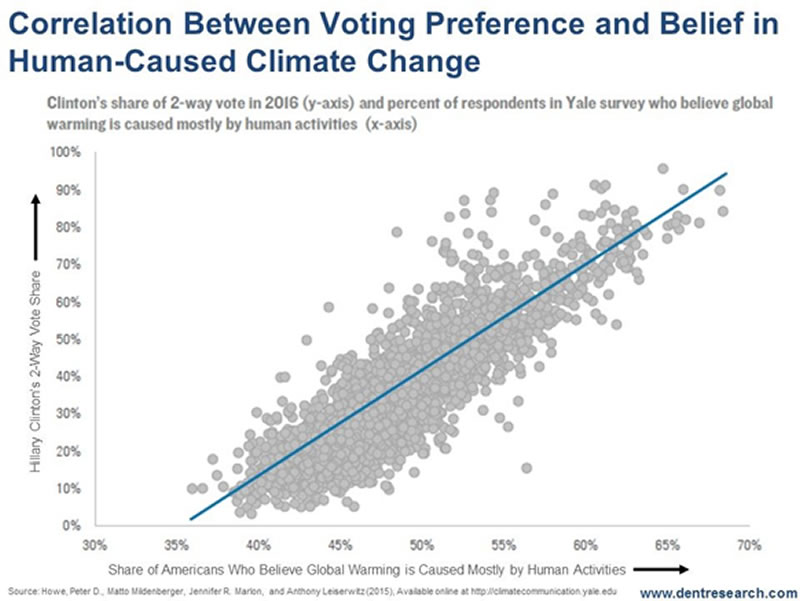Discover Why A Major American Revolution Is Brewing
Politics / US Politics Jul 19, 2017 - 03:10 AM GMTBy: Harry_Dent

 I have written many articles on how extremely polarized our politics has become in the last decade. I’ve dedicated several Leading Edge newsletters to the topic. I talked about it at our 2016 Irrational Economic Summit. I even discuss it briefly in my new book, Trump, Brexit, and the Next Civil War, which will be available around mid-August.
I have written many articles on how extremely polarized our politics has become in the last decade. I’ve dedicated several Leading Edge newsletters to the topic. I talked about it at our 2016 Irrational Economic Summit. I even discuss it briefly in my new book, Trump, Brexit, and the Next Civil War, which will be available around mid-August.
I talk about it so much because it’s related to the mega 250-Year Revolution Cycle sweeping over us right now. We’ll feel the effects of this cycle for decades to come… which I detail in my new book.
But today I want to show you another aspect of this divide. Look at this chart.

There are a number of partisan issues that delineate the differences between red and blue voters, and this is clearly one of them. The chart on red versus blue voting in the last presidential election is nearly identical to this one.
When you look more closely, you can see that the red/blue split in our country is more a rural/urban split. Roughly 20% of our population lives in major cities, 60% in suburbs, and 20% in rural areas. Those closer to the larger cities tend to lean more toward liberal views.
Even in the largest red state – Texas – Dallas and Houston residents tend to be more liberal, although not as liberal as Austin, with Willie Nelson as its mascot.
The rural areas are more conservative. It’s no surprise that states like Nebraska, Kansas, Oklahoma, West Virginia, Kentucky, Tennessee, Wyoming, and Alaska were red states during last year’s election. They have huge swathes of rural land.
This is important because of this…

For the longest time after the election, there was all this debate about why Clinton lost. The truth is that Trump won the rural white vote by margins of 80%-plus… much higher than Clinton won the traditional working class and voters living in the inner-cities.
I saw a show a while back about a rural county in Alabama where Trump got 89% of the vote! The formerly blue states that turned red for Trump, like Pennsylvania, Ohio, Michigan, and Wisconsin have large rural, red areas!
The strong rural red leaning also explains why the Republicans were favored twice by the electoral college. It favors land mass a bit more than voter density – as does the two senators per state, which gives low population rural states like Wyoming more representation.
I’m not taking sides here. I lean red on some issues (more fiscal) and blue on others (more social). But the current split across the country is an unsustainable imbalance. The U.S. is the most politically polarized of the major developed countries, and it has the highest income inequality that just adds fuel to the polarization fire.
These imbalances block upward mobility, which is a fundamental cornerstone of democracy, innovation, and progress, as is the ability to compromise for effective political change.
We have a revolution coming on a convergence of my 250-Year Revolution and Andrew Pancholi’s 84-Year Populist Revolution cycle. America is going to be at the center of this. This revolution will be as big – if not bigger – than the one that brought us democracy, and the Protestant Reformation in Europe before that.
Watch out for the release of my new book. As a loyal subscriber, you’ll have exclusive access before it goes to the general public in 2018.
Harry
Follow me on Twitter @HarryDentjr
Harry studied economics in college in the ’70s, but found it vague and inconclusive. He became so disillusioned by the state of the profession that he turned his back on it. Instead, he threw himself into the burgeoning New Science of Finance, which married economic research and market research and encompassed identifying and studying demographic trends, business cycles, consumers’ purchasing power and many, many other trends that empowered him to forecast economic and market changes.
Copyright © 2017 Harry Dent- All Rights Reserved Disclaimer: The above is a matter of opinion provided for general information purposes only and is not intended as investment advice. Information and analysis above are derived from sources and utilising methods believed to be reliable, but we cannot accept responsibility for any losses you may incur as a result of this analysis. Individuals should consult with their personal financial advisors.
© 2005-2022 http://www.MarketOracle.co.uk - The Market Oracle is a FREE Daily Financial Markets Analysis & Forecasting online publication.


